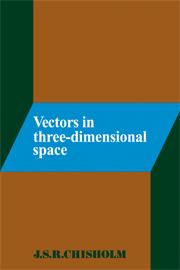Book contents
- Frontmatter
- Contents
- Preface
- 1 Linear spaces and displacements
- 2 Scalar products and components
- 3 Other products of vectors
- 4 Transformations of vectors
- 5 Curves and surfaces; vector calculus
- 6 Vector analysis
- Appendix A Some properties of functions of two variables
- Appendix B Proof of Stokes' theorem
- Reference list
- Outline solutions to selected problems
- Index
6 - Vector analysis
Published online by Cambridge University Press: 28 January 2010
- Frontmatter
- Contents
- Preface
- 1 Linear spaces and displacements
- 2 Scalar products and components
- 3 Other products of vectors
- 4 Transformations of vectors
- 5 Curves and surfaces; vector calculus
- 6 Vector analysis
- Appendix A Some properties of functions of two variables
- Appendix B Proof of Stokes' theorem
- Reference list
- Outline solutions to selected problems
- Index
Summary
Scalar and vector fields
In almost every branch of mathematical physics, we have to deal with physical quantities which extend continuously through regions of 3-space. These regions and their boundaries do not usually have any awkward features; we therefore assume that they can be described mathematically as volume regions and smooth surfaces which satisfy the conditions set out in Chapter 5. We also assume that any curves in physical space can be validly represented as piecewise smooth curves. Volumes, areas of surfaces and lengths of curves can therefore be defined. We can also define integrals of functions along curves, over surfaces and throughout volumes, provided that the region is finite and the functions are piecewise continuous; these definitions are based on analytic theorems established in Appendix A.
In this chapter, we shall be studying the analysis of functions in 3-space which might represent the properties of, for example, fluids, gravitational or electromagnetic fields, stress and strain in solids, or wave functions in atoms, molecules and nuclei. Such a function may be unbounded when the position vector tends to certain points, curves or surfaces; for example the electrical potential of a point charge e at the origin is e/r, which is unbounded near the origin (r = 0). Special care must be taken in the study of functions in regions where they are unbounded; we shall concentrate our attention on the analysis of functions in regions where they are ‘well-behaved’. By ‘well-behaved’ we not only mean that a function is continuous, but also that any derivatives we use exist and are continuous.
- Type
- Chapter
- Information
- Vectors in Three-Dimensional Space , pp. 203 - 252Publisher: Cambridge University PressPrint publication year: 1978



